| Botanical Name |
|
| Family |
Asphodelaceae - The Asphodel family.
|
| Pronunciation |
bul-BEEN lat-ih-FOE-lee-ah |
| Common Name(s) |
Afrikaans: Geelkopieva; Waterglas
IsiXhosa: ibhucu; Incelwane
|
| Plant Group |
- Ground Cover A plant with a low-growing, spreading habit, grown specifically to cover the ground.
- Succulent A plant having fleshy stems or leaves often adapted to dry conditions.
|
| Plant Size |
- Small to Medium
| Tree | 8m to 15m |
| Shrub | 75cm to 1m |
| Perennial/ground cover | 20cm to 40cm |
| Bulb | 30cm to 40cm |
| Succulent | 20cm to 40cm |
|
| Position |
- Canopy Shade Canopy shade is found below closely grown trees where some light filters through. Ideal for the protection of herbaceous plants.
- Light or Dappled Shade Found below trees with sparse, open foliage. Ideal for the protection of herbaceous plants.
- Partial Shade The area is in shade for part of the day and in full sun for part of the day.
- Sun The area is in full sun for all or most of the day, all year round.
|
| General Information |
- Drought Tolerance: High The plant is well adapted to arid conditions; it can survive long periods of drought and high temperatures without extra water.
- Evergreen Plants that have leaves all year round.
- Frost: Half-hardy The plant is able to survive low temperatures and some frost but requires protection against severe frost.
- Sand tolerant Plants adapted to survive in nutrient poor, very sandy soils.
- Water Wise Plant species originating from low rainfall regions that require less water to survive and thrive than other plant species.
|
| Specific Information |
Bulbine latifolia is aloe-like in appearance, having rosettes of triangular, apple-green leaves that curve back slightly and taper to a point. However the leaves are very fleshy and have no spines. The leaves store a great deal of water, making it an ideal plant for the water wise gardener. It grows in full sun but is often shaded by shrubs or rocks for part of the day in areas where the climate is mild and little, if any, frost occurs. In prime conditions it can grow up to 30 cm tall and 30 cm across. However, in my garden, under less than perfect conditions, they seldom grow over 20 cm across. Each rosette produces around 4 flower heads at a time and if the stems are removed when the flowers fade, they will produce more flowers. They self-seed vigorously.
|
| Ad Break |
|
| Flowers |
| Description |
stout stalks with densely packed, small, star-shaped flowers
|
| Season |
- Spring Plants will seldom bloom for the entire season as given in the list, but should flower during a period within these parameters.
|
| Colour |
|
| Growth Rate |
- Fast Specifying growth rate can be very misleading as there is considerable variation of growth rate depending on type and species of plant, available water, supplementary feeding, mulching and general care, as well as the plants suitability and adaptability to the garden environment.
|
| Plant Uses |
- Attracts bees, butterflies or other insects This plant attracts insects which can be food for birds or other creatures in your garden.
- Container Trees, shrubs and ornamental species that can adapt to growing in a restricted environment.
- Edging A low growing plant that provides softness or definition to the edges of a bed or walkway.
- Filler Either a fast growing tree or shrub used temporarily to fill in an area while the permanent plants grow to a desired size, or a plant used to fill gaps in borders or beds.
- Ground Cover Low-lying plants that spread fast, require minimal maintenance, and cover large expanses or bare areas between bulbs or shrubs. They provide protection from erosion and drought and improve the visual appearance of the garden.
- Interplanting Arranging and planting plants in the garden that have different blooming times and habits of growth, extending the amount of time in which the area is in flower.
- Mass Planting Plants useful for filling a large area with just one or a few kinds of plants spaced close together. Creates a bold, dramatic effect and to reduces maintenance.
- Pioneer for new gardens A very fast growing plant, able to withstand hardship, that can be used to populate land that has recently been cleared of natural vegetation. These plants pave the way for slower-growing species by adding nutrients to the soil and creating leaf litter.
- Pot Plant A plant that needs a protected environment on a patio or indoors.
- Rock Garden An area constructed of larger rocks, arranged naturally, to emphasise the use of stones as a main element. Generally plants used do not need a lot of care.
- Stabilize Banks Plant is used to prevent soil erosion because their roots will form a mat that stabilizes the soil and keeps it from washing away in heavy rains.
- Suitable for coastal gardens Plants adapted to dry, sandy soil, forceful wind, limited rainfall and intense sunlight.
- Water Features These plants may have dramatic, lush foliage or graceful form. They do not shed excessive leaves and do not have invasive root systems.
- Wild Garden An indigenous garden planted for the benefit of wildlife and birds. Provides food, water, a variety of mini-biomes and no poisonous chemicals are used.
|
| Distribution and Habitat |
in the Eastern Cape, KwaZulu-Natal and Mpumalanga, in thicket vegetation, dry river valleys, gorges and on cliffs
|
| Planting Suggestions |
Bulbine latifolia needs well-drained soil, preferably enriched with compost. For containers and pots use a sandy garden soil mixed with compost. The references I have consulted all suggest full sun for this species, but in my garden the leaves yellowed, growth was very slow and flower heads withered. This is possibly due to drought. I have moved the plants to a light shade position and given them a moderate amount of water. Growth, colour and flowering have improved.
The rapid growth of Bulbine latifolia makes it ideal for the new garden. The plants live from 5-8 years and are best replaced when they lose vigour - although they seed so easily that this is seldom necessary. It is relatively pest free, but may have occasional fungal infection causing dark leaf spots. These can be treated with a fungicide. I have also found that they are attacked by snout beetles which cause the plant to rot and die.
|
| Medicinal Uses |
|
| Ad Break |
|


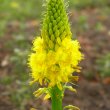
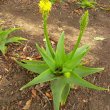
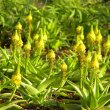
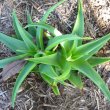
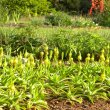



Discuss this plant
Share knowledge, ask a question or give an experience.